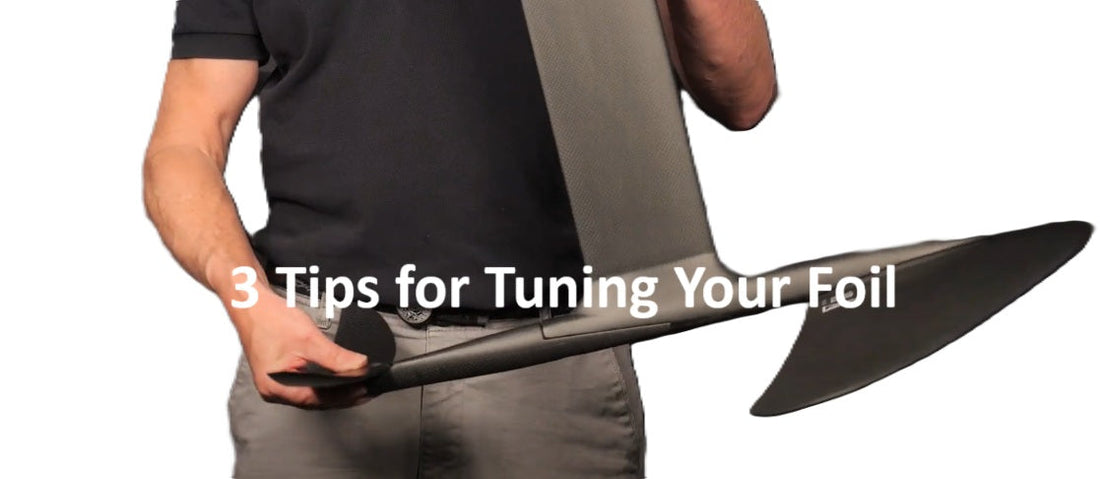Foil Positioning
Start here if you’re riding with foot straps or using a very short board—proper foil placement relative to your feet is key.
The goal is balanced pressure between your front and back foot. If, at your normal riding speed, it feels like the front of the board is constantly lifting—pushing against your front foot—that’s a sign of too much front foot pressure.
To fix it, you can:
-
Move yourself forward relative to the foil, or
-
Move the foil back relative to you.
You're looking to align the front wing under the foot that’s feeling less pressure.
If you’re riding strapless and have room to move around on the board, positioning becomes less of a problem—unless the board is just too short.
In certain situations, some foils and some boards just aren't a good fit, and no matter how far forward or backward you put that foil, it's just not going to feel right. At that point, you have to commit to maybe changing out the kind of board you have or switching to a different foil — because you've reached their limits.
Rider size also matters. Everyone’s ideal foil position varies depending on weight, height, and typical riding speed. A setup that works perfectly for one person might feel completely off for someone heavier or taller.
Angle of Attack
The hydrofoil’s front wing needs to ride at a certain angle—called the angle of attack—to create lift. Heavier riders riding at the same speed as lighter riders will have a higher angle of attack, which usually means:
-
The nose rides higher.
-
The wing pushes further forward underwater.
-
You feel more front foot pressure.
Let’s say a 150 lb rider has everything dialed at 17 mph with balanced foot pressure. If their 230 lb buddy hops on the same setup, they’ll ride at a higher angle and experience heavy front foot pressure. That’s just physics, not a flaw in the foil.
Taller riders may also feel more nose-down pressure, because their weight acts from higher up, affecting the foil’s drive.
Moral of the story: Everyone needs to find their own sweet spot.
Stabilizer Tuning
Once you’ve dialed in your basic foil position, you can fine-tune by adjusting the stabilizer angle to maintain balanced pressure as you increase speed.
Many foils feel great at moderate speeds, but as you go faster (say, from 15 to 20+ mph), the board’s trim changes. You’ll often feel increasing front foot pressure—the board wants to lift out, and you’re constantly fighting it.
To fix that, shim the stabilizer to reduce its downward force:
-
Lift one edge of the stabilizer slightly using a shim (a snipped-up expired credit card works great).
-
If the stabilizer mounts on top of the fuselage, place the shim under the front screw.
-
If it’s mounted under the fuselage, shim behind the trailing edge.
-
This reduces front foot pressure at high speeds, making the foil feel livelier and more responsive. Beginners may prefer a bit more front foot pressure, but as you progress, you’ll want that clean, neutral trim.
Try one shim, then two, then three — experiment until it feels just right. There are no hard rules.
Surface Finish (Sanding for Speed)
A smooth foil is a fast foil. Many hydrofoils come with a rough or imperfect factory finish, especially on the wings.
If you’re willing to put in a bit of elbow grease, wet sand your foil for better performance:
Materials:
-
Wet/dry sandpaper: 360, 400, 600, and maybe 1200 grit
-
Foam sanding block
Process:
Sand the surface of the wings and mast-
-
Start with 360 grit and work up to finer grits.
- Sand in diagonal strokes, alternating direction occasionally.
- Finish with 600–1200 grit.
Sand the Trailing edge of the wings and mast-
-
Check the trailing edges — if they’re super sharp, dull them slightly using 360 grit and a wood or plastic block.
-
Sand them down to about credit card thickness, then round the edges with a foam block.
-
Finish with 600–1200 grit.
A smooth trailing edge reduces drag, vibration, and noise. Bonus: it’s safer — no more foil cuts.
Summary
So the three main points:
-
Foil Positioning: Move your straps or the foil itself so you balance front and back foot pressure.
-
Stabilizer Shimming: Adjust stabilizer angle to maintain neutral trim at all speeds — especially to reduce front foot pressure at high speeds.
-
Surface Finish: Wet sand your foil for smoother surfaces, better performance, and safety.
If you do these three things, you can take any hydrofoil you own and significantly increase its performance.
If you're interested in Delta Hydrofoil, check us out at deltahydrofoil.com or at Green Hat Kiteboarding. We're dedicated to making the best foils we can for winging and kiting.

